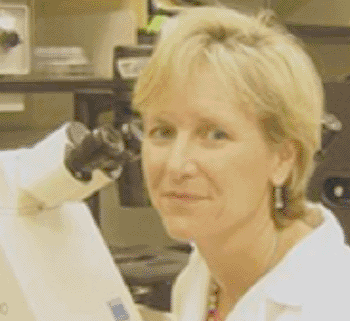Silencing the HMGA1 Gene Blocks Metastasis in Breast Cancer
By LabMedica International staff writers
Posted on 13 May 2013
Blocking the activity of the protein encoded by the HMGA1 (high mobility group A1) gene in breast cancer cells renders them less aggressive and diminishes their ability to metastasize.Posted on 13 May 2013
The HMGA1 gene encodes a nonhistone protein involved in many cellular processes, including regulation of inducible gene transcription, integration of retroviruses into chromosomes, and the metastatic progression of cancer cells. The encoded protein preferentially binds to the minor groove of adenine + thymine-rich regions in double-stranded DNA. It has little secondary structure in solution but assumes distinct conformations when bound to substrates such as DNA or other proteins. The encoded protein is frequently acetylated and is found in the nucleus.

Image: Senior author Dr. Linda Resar (Photo courtesy of Johns Hopkins University).
Investigators at Johns Hopkins University (Baltimore, MD, USA) have been studying the role of HMGA1 in cancer growth and spread for more than 20 years. In the current paper, they described experiments with "triple negative" breast cancer cells—those that lack hormone receptors or HER2 gene amplification—in which HMGA1 expression had been silenced.
They reported in the May 2, 2013, online edition of the journal PLOS ONE that silencing HMGA1 expression in the aggressive, invasive triple negative breast cancer cells dramatically halted cell growth and resulted in striking morphologic changes from mesenchymal-like, spindle-shaped cells to cuboidal, epithelial-like cells. Mesenchymal genes were repressed, while E-cadherin was induced in the cells that lacked HMGA1 expression. Loss of E-cadherin function or expression has been implicated in cancer progression and metastasis. E-cadherin down regulation decreases the strength of cellular adhesion within a tissue, resulting in an increase in cellular motility. This in turn may allow cancer cells to cross the basement membrane and invade surrounding tissues.
Silencing HMGA1 also blocked oncogenic properties, including proliferation, migration, invasion, and tumorigenesis. Metastatic progression following mammary implantation was almost completely abrogated in the HMGA1 knockdown cells. Moreover, silencing HMGA1 inhibited the stem cell property of three-dimensional mammosphere formation, including primary, secondary, and tertiary spheres. In addition, knockdown of HMGA1 depleted cancer initiator/cancer stem cells and prevented tumorigenesis at limiting dilutions.
Unmodified and HMGA1 cells were injected into separate groups of mice. Mice receiving unmodified cells developed tumors that grew and spread to other areas, such as the lungs. In contrast, mice that received HMGA1 knockdown cells developed small tumors that did not spread to distant sites.
"The aggressive breast cancer cells grow rapidly and normally appear spindle-shaped or thin and elongated," said senior author Dr. Linda Resar, associate professor of medicine, oncology, and pediatrics at Johns Hopkins University. "Remarkably, within a few days of blocking HMGA1 expression, they appeared rounder and much more like normal breast cells growing in culture."
"This master regulator is normally turned off in adult cells, but it is very active during embryonic development and in all highly aggressive tumors studied to date," said Dr. Resar. "Our work shows for the first time that switching this gene off in aggressive cancer cells dramatically changes their appearance and behavior."
The investigators now intend to focus on ways to target HMGA1 in therapy.
Related Links:
Johns Hopkins University














